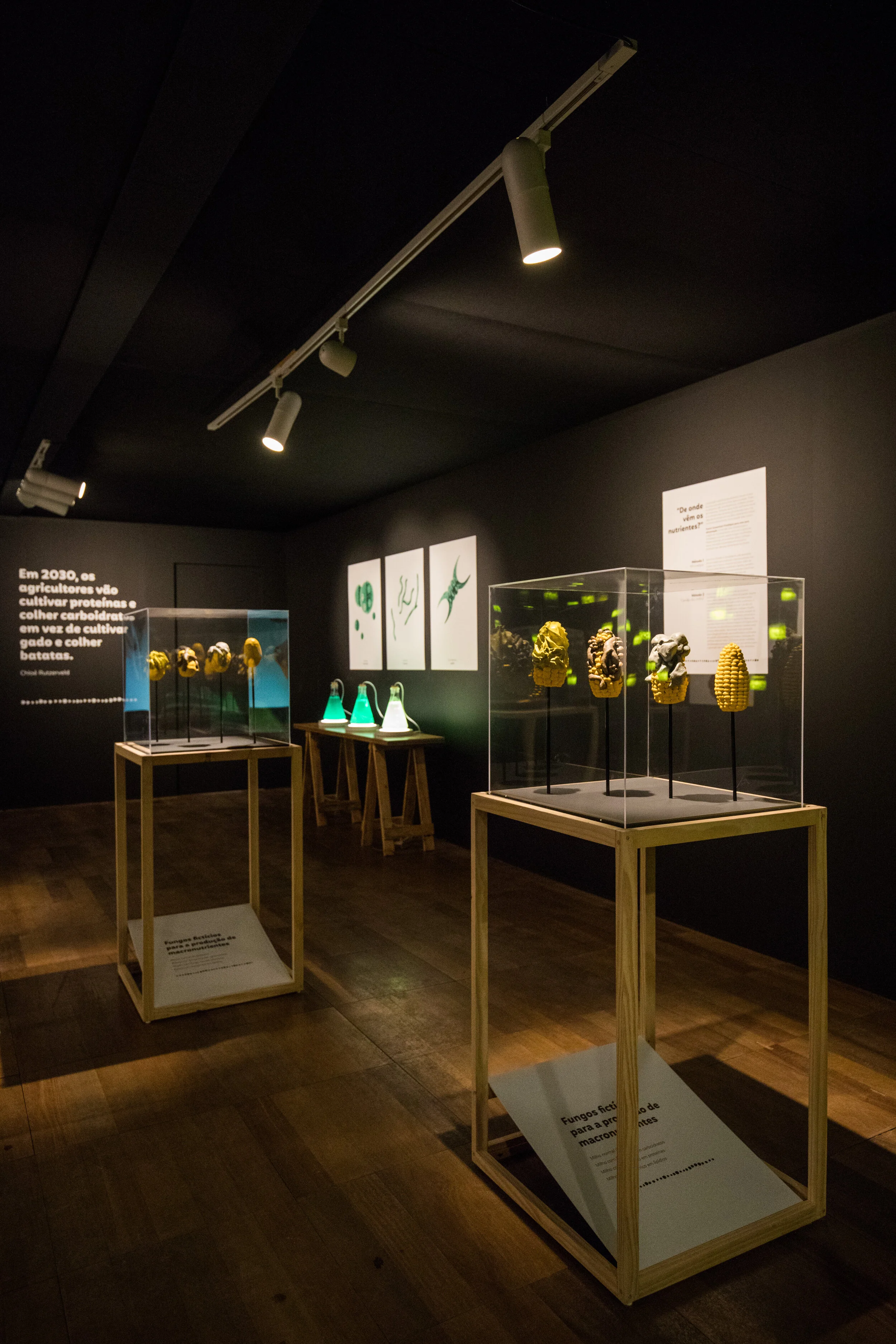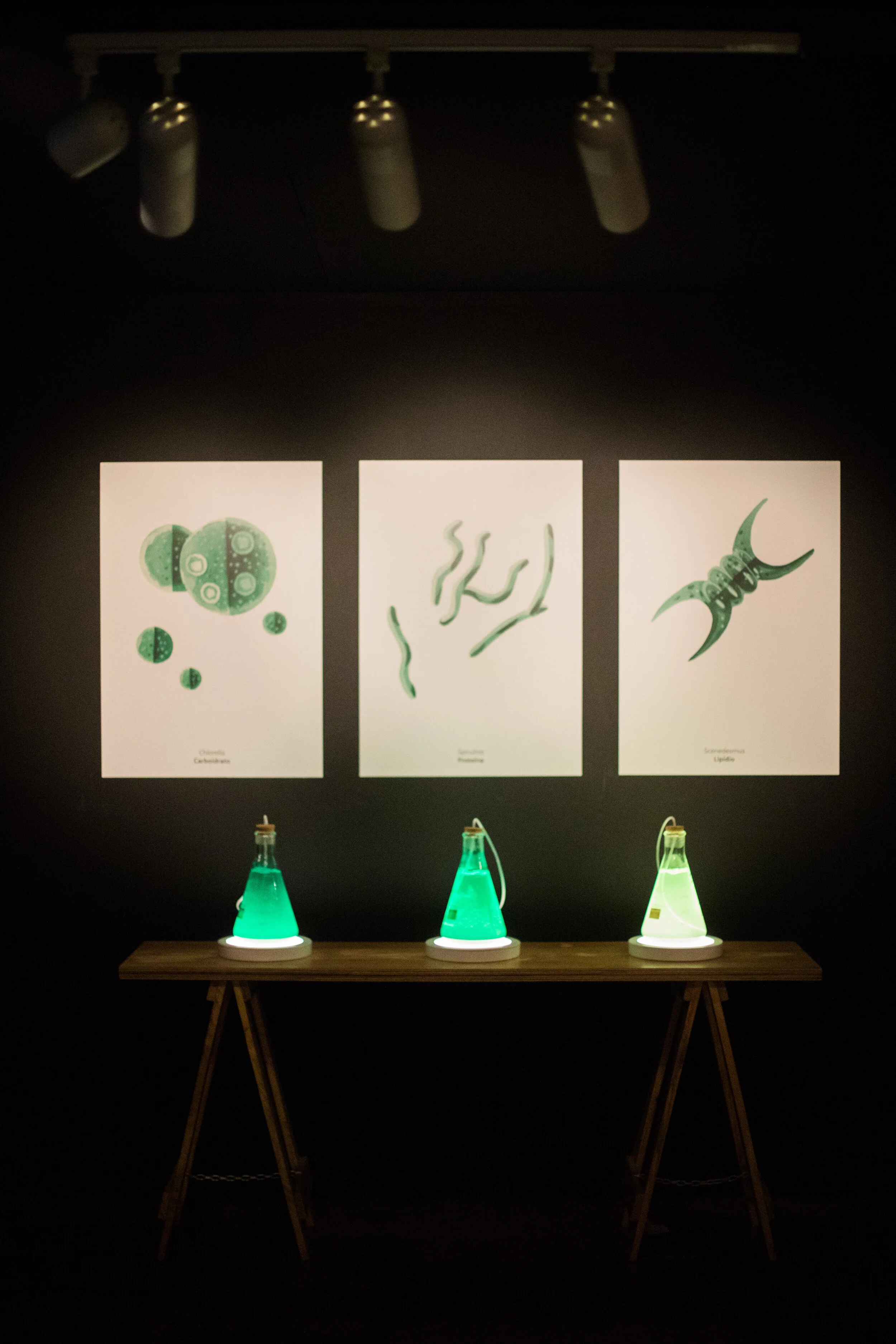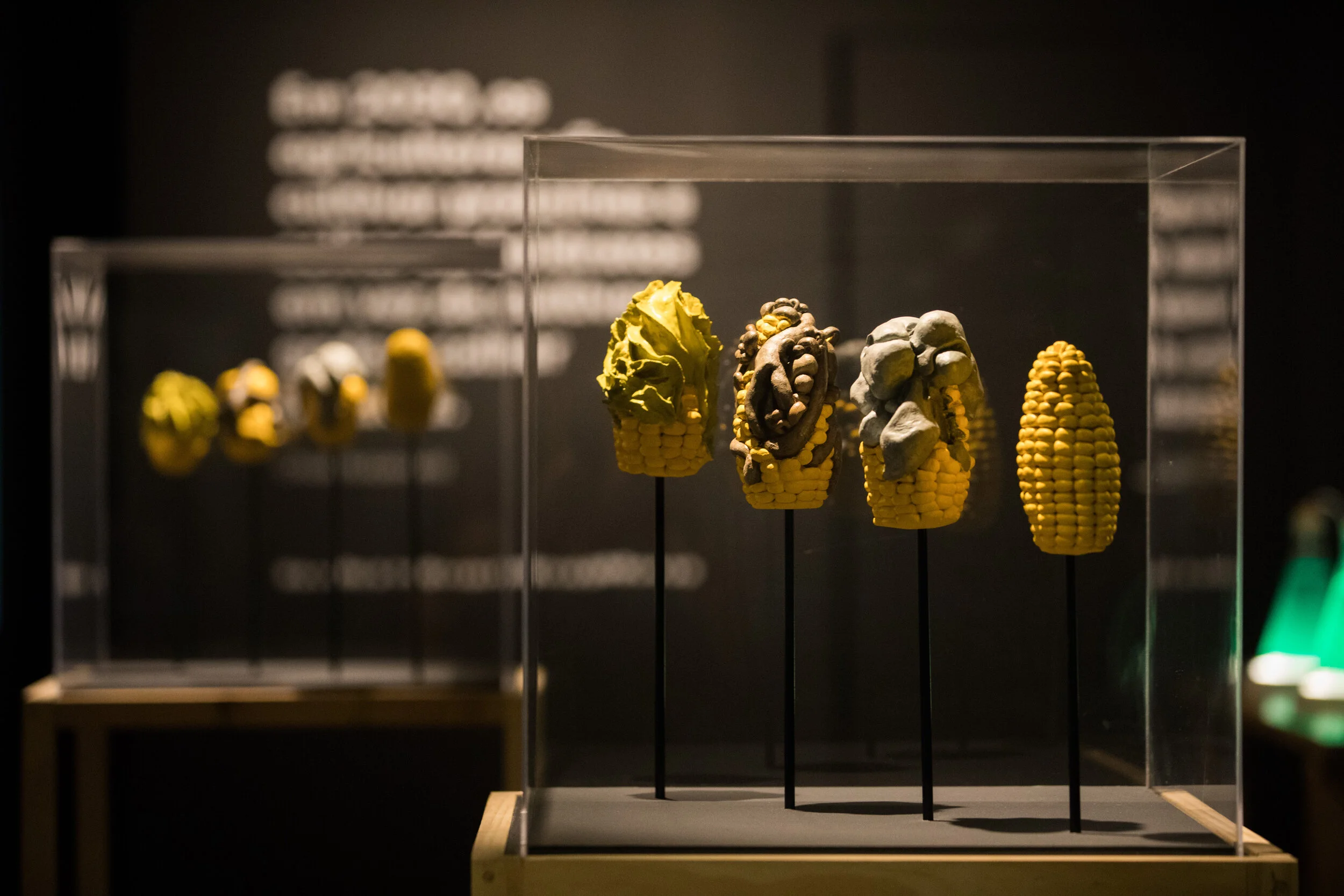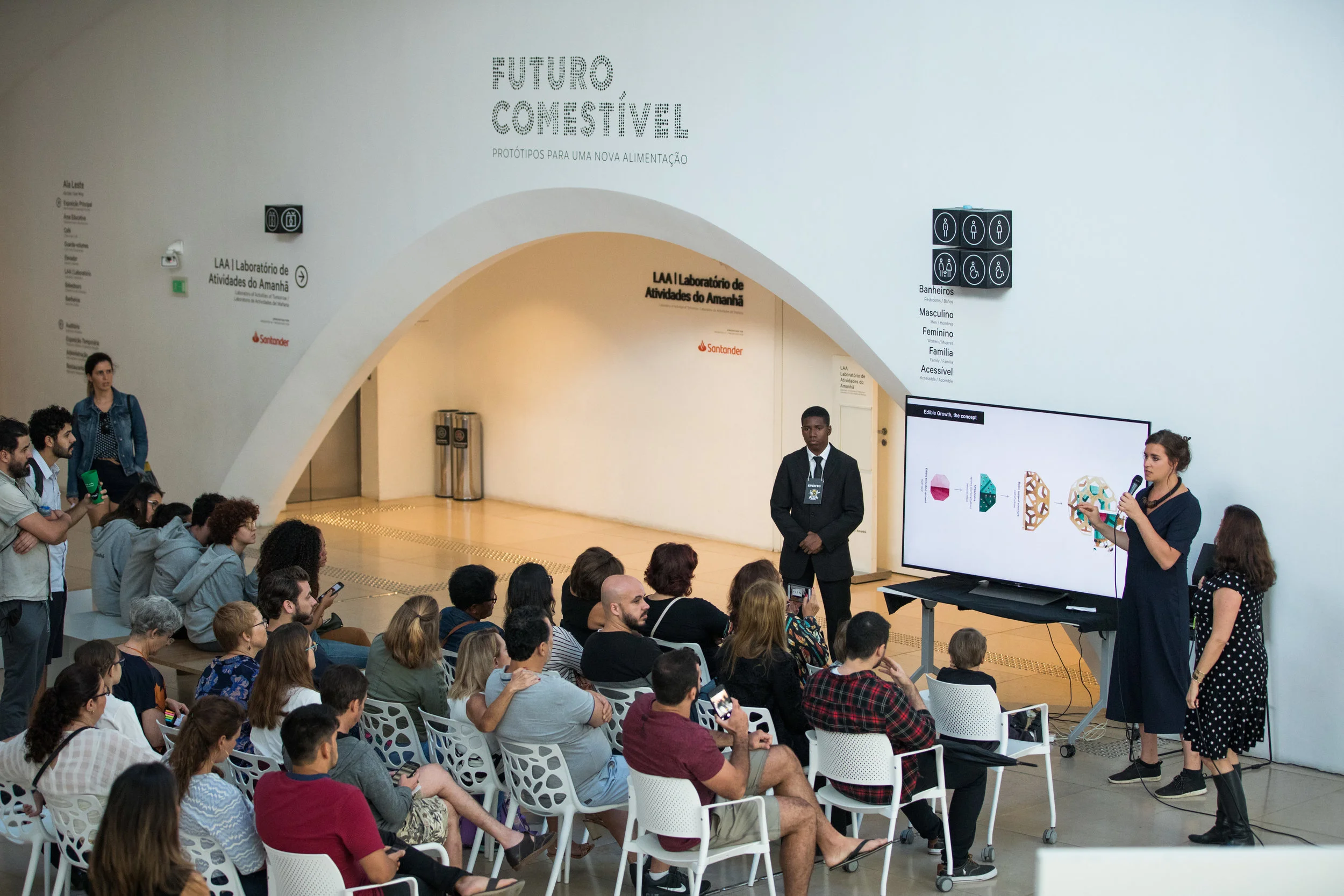Edible Future
Prototypes for a new diet
Solo exhibition as result of artistic residency in Rio de Janeiro at the Museum of Tomorrow
Duration: Nov 2018 - April 2019
In collaboration with: Museu do Amanha & Dutch Embassy
Many thanks to: Marcela Sabino - Lab director and her team
Edible Future: Prototypes for a new diet
Edible Future: Prototypes for a new diet
Food is the basis of our survival. It nourishes us, gives us energy and support to live. Food represents history, affection, diversity, individuality and culture. It serves as metaphor and as language; it possesses sensorial, artistic, ritualistic and religious aspects. Food appears in specific geographies, but spreads throughout the world, giving flavor to regions and societies.
Over 10,000 years ago humans began to exercise control and organization over the nature that surrounds us, giving rise to farming and animal husbandry. Over the centuries, this process has accelerated the development of civilization. Today these systems are industrialized and enable the production of large quantities of food. But these same systems have brought us closer to a critical future, in which natural resources have exhausted their limits of regeneration, and the Earth's population has reached record highs. How will we feed 10 billion people in the 2050s with equality, quality and sustainability?
As the result of a one-month artistic residency at the Laboratory of Tomorrow´s Activities of the Museum of Tomorrow | LAA, with the support of the Consulate General of the Netherlands, Dutch food futurist Chloé Rutzerveld, envisions a new food system. Through an interdisciplinary approach, Chloé combines aspects of design, science and technology, always thinking of new ways to make the production and consumption of food of the future healthier, more efficient and sustainable - of course, with a Brazilian touch.
“Chloé is a stunningly unique thinker. She has the uncanny ability to look at the world around her and extract surprising insights that deeply challenge the status quo. She uses her storytelling abilities to weave a compelling narrative around possible food futures. She then uses her artistry to bring these potential futures to life in exhibitions, workshops and installations that provoke audiences to see the world through a completely new vantage point. ””
What if we could create a new food system that provides 100% efficient digestion at a low cost and which is sustainable for the planet?
Where do the nutrients come from?
That was the main question for the creative residence.
Traditional food production requires many natural resources such as land, water and energy. All foods consist of multiple groups of nutrients. Therefore, it would be very inefficient to extract nutrients from existing foods to create functional capsules. Instead, we could grow nutrients directly through micro-organisms, as this exhibition proposes.
Edible Future: Prototypes for a new diet contemplates two methods for the creation of micronutrients: one with the help of microalgae and the other using modified fungi. In these systems, the nutrients would be harvested, dried, crushed and stored in powder form for the production of functional food capsules.
Method 1 - Microalgae
Spirulina, Chlorella and Scenedesmus are examples of microalgae that produce macronutrients that could be used for human consumption. In addition to providing carbohydrates, proteins and lipids, they also contain antioxidants and micronutrients (vitamins and minerals). Chlorella has a high carbohydrate content, Spirulina has a high protein content and Scenedesmus has a high lipid content.
Method 2 - "Corn smut"
Another unconventional method of producing nutrients is to develop large-volume crops such as corn, potatoes or wheat to serve as hosts for nutrient-rich fungi. The inspiration for this method comes from "corn smut," a disease caused by Ustilago maydis, a parasitic fungus that spreads through the ears of corn. This fungus contains carbohydrates, proteins and lipids and is considered a delicacy in Mexico, for example. This new method imagines fungi as producers of carbohydrates, proteins and lipids for our food. To scale this production, these fungi could be modified and grown in controlled air-conditioned cells installed in abandoned buildings. The fungi would be harvested, dehydrated and processed into a nutritious powder for the production of functional food capsules.
“By 2030, farmers will grow protein and harvest carbohydrates instead of growing livestock and harvesting potatoes” - Chloé Rutzerveld
Method 1 - Microalgae
Growing Spirulina, Chlorella and Scenedesmus for direct nutrients.
Method 2 - "Corn smut"
An unconventional idea of producing nutrients by developing different kinds of ‘smut’ (nutrient-rich fungi on host).
Corn smut, potato smut…
Prototype: Feijoada System 1 – Capsules mounted in the order of digestion
Carbohydrates - proteins - lipids - micronutrients. Enriched by textures, colors and custom smells.
What will be the taste, smell and appearance of food if we apply the new encapsulation system in the order of digestion? Will the adoption of this new system be faster if the format of the food is similar to what we have been eating for centuries? On the other hand, would it be better to imagine completely new shapes, textures, and combinations of flavors?
A new food system will open the door to new experimentation and may pave the way for us to leave aside the perception of what we have identified as food. The emergence of these new foods will directly influence our food culture, the cutlery and tools we use, in addition to the way food is manufactured and arrive at our homes.
Prototype - Feijoada System 2 - Casing with smaller capsules inside
Carbohydrate layer is used as an envelope. In the interior, there are smaller capsules with protein - lipid and micronutrients protected by a membrane so that they are digested in the designated place in the body.
As the carbohydrate layer is digested in the mouth because of the presence of the enzyme amylase in our saliva, we can change the food experience and texture of food by creating a shell containing smaller capsules. The proposal is to facilitate the transition phase of a new food system, offering food that seems more familiar to the palate, such as a feijoada (a traditional Brazilian dish), for example. That is, although the ingredients may resemble those of a feijoada, all the components would be digitally manufactured from alternatively sourced nutrients.
During the opening of Edible Future @Museum of Tomorrow






